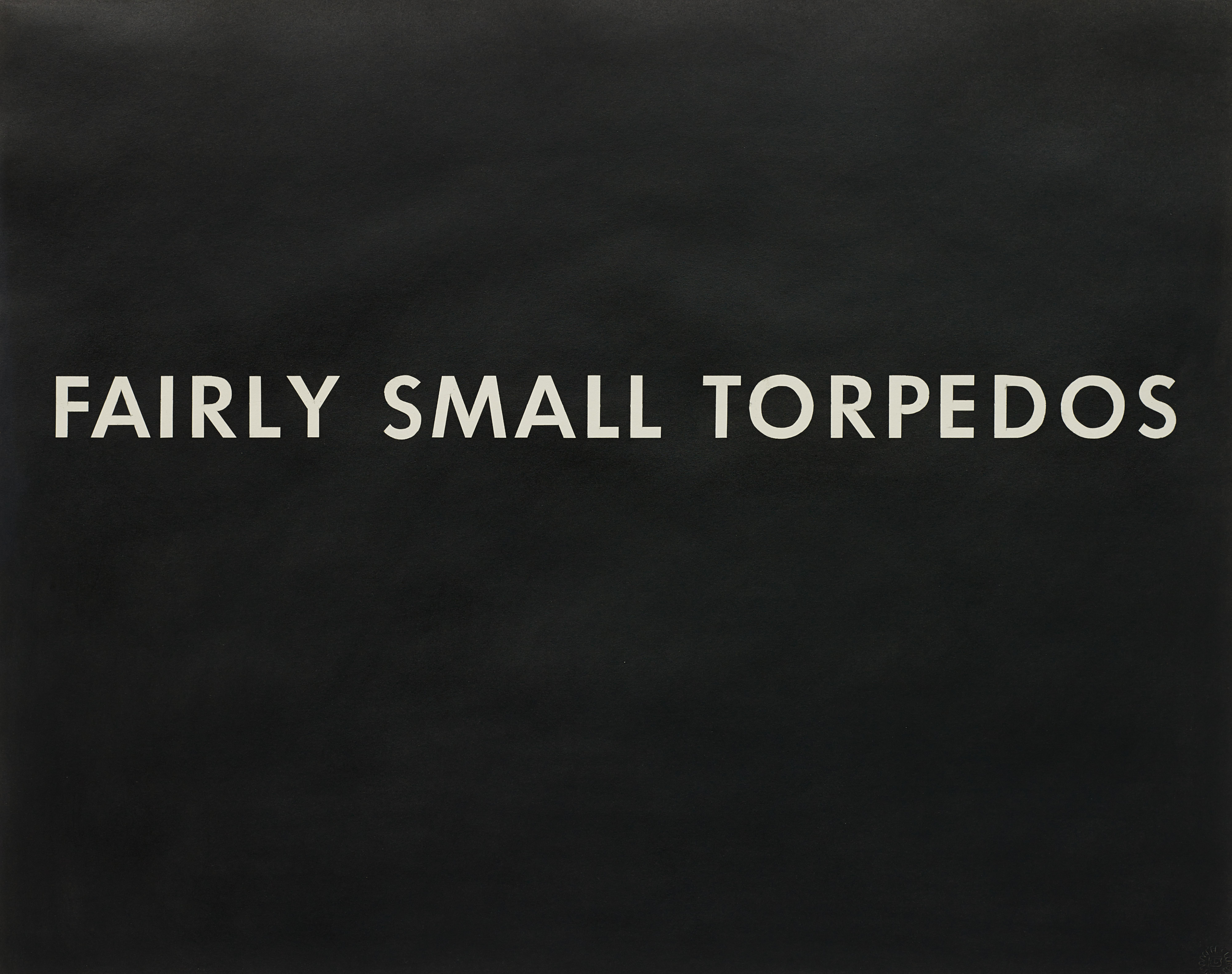

34Ο◆
Ed Ruscha
Fairly Small Torpedos
Full-Cataloguing
This distinct genesis in print media heavily influenced Ruscha’s eventual aesthetic. Beyond simply forming a Southern Californian brand of Pop Art, Ruscha’s work displays a deep textual vision that is uniquely his own. In his pieces, words are given a physical voice, and their evocative potential fully realized in clashes between the banal and the majestic. ‘Some Pretty Eyes’ are blankly juxtaposed with ‘Some Electric Bills;’ ‘Pay Nothing Until April’ is stamped on a sublime photorealistic mountain. An admirer of J.G. Ballard and Don DeLillo, Ruscha sees the dark and apocalyptic face of modernity, but a Pop sense of humour smiles wryly through much of his work.
The present lot dates from an experimental period that began in the late 1960s, and saw Ruscha explore a range of unorthodox materials. His 1969 Stains series features substances as wide-ranging as egg yolk, turpentine, beer, salad dressing, Pepto-Bismol, and the artist’s own blood. During this time, Ruscha also came to regularly employ gunpowder as a medium, enjoying its colour and texture and the ease it offered in correcting mistakes. ‘I happened to have, just by accident, this little canister of gunpowder, and I thought: well, that’s a powder, like charcoal and like graphite, and why can’t that be used?’ (Ed Ruscha, Artist Ed Ruscha discusses his use of gunpowder [video], SFMOMA, July 2004).
From this spontaneous inception sprung some of Ruscha’s most distinctive work. Gunpowder pieces like Nashville and So spell out their titles in white ribbons of cursive longhand, transforming the textual into the ornamental. The present lot is rather less decorous than these works. The stark black and white palette lends the piece an unnerving impassivity. The effect is of a dispassionate sci-fi news bulletin or a phrase removed from an arcane poem. Belonging to a dystopia that is both familiar and remote, the words confront the viewer as some inviolable and perhaps unwelcome truth. Yet it is a truth that remains essentially ungraspable, belonging wholly to the realm of neither fact nor fiction. As is so often the case in the artist’s work, the viewer is suspended between enlightenment and mystification.
Discussing his use of gunpowder, Ruscha emphasizes pragmatic concerns; ‘the gunpowder itself is in granules. I could see it would make a good choice of materials; it could actually impregnate on paper … It became a material that I could correct.’ (Ed Ruscha in Paul Kalstrom, ‘Interview With Ruscha In His Hollywood Studio,' Ed Ruscha, Leave Any Information At The Signal, Cambridge, MA: MIT Press, 2004, p.155). Speaking about process and materiality, he makes no mention of the associative weight of gunpowder. However given the title and content of the piece, the medium’s connotations are unavoidable. A meta sensibility creeps into the work, just as it does in his trompe l’oeil splash of water forming the word ‘Drops.’ Rendered in gunpowder, the phrase ‘Fairly Small Torpedos’ becomes self-referential; the words are the weapons which they denote.
The weaponisation of text gestures towards the lurid Watergate climate of 1974, a year in which applications to journalism school had reached an all-time high. Words had become arms; the recording that led to Nixon’s downfall was called the ‘Smoking Gun’ tape. Such are the connotative possibilities of the painting. Yet at the very point of signification, the text re-solidifies into an unspeaking object. It is this interplay between signification and its negation which makes Ruscha’s work so beguiling. The artist is as ambivalent about this dynamic as the pieces themselves: ‘Sometimes I don’t care about the definition of the words. Sometimes they are just a simple excursion, start-stop, unto itself … Then other times, like you say, I can’t escape the fact that, say, the word “Annie” would mean many things to many people’ (Ed Ruscha in Paul Kalstrom, ‘Interview With Ruscha In His Hollywood Studio,' Ed Ruscha, Leave Any Information At The Signal, Cambridge, MA: MIT Press, 2004, p.192).
In a contemporary context, Ruscha’s words even have much in common with the randomised phrase generation of CAPTCHAs, which require a user to type out a combination of words to prove that they are human – perhaps the ultimate in the semiotics of postmodernity. His words may emerge as objects but don’t necessarily remain so; instead they have the potential to be re-imagined as overhead conversation, snippets of verse, or a half-glimpsed headline. Ruscha pulls absurdity from the flux of mass media into a coherent statement of his penetrating gaze. In Fairly Small Torpedoes, he creates an artwork as conceptually wise as it is graphically striking.
Ed Ruscha
American | 1937Quintessentially American, Ed Ruscha is an L.A.-based artist whose art, like California itself, is both geographically rooted and a metaphor for an American state of mind. Ruscha is a deft creator of photography, film, painting, drawing, prints and artist books, whose works are simultaneously unexpected and familiar, both ironic and sincere.
His most iconic works are at turns poetic and deadpan, epigrammatic text with nods to advertising copy, juxtaposed with imagery that is either cinematic and sublime or seemingly wry documentary. Whether the subject is his iconic Standard Gas Station or the Hollywood Sign, a parking lot or highway, his works are a distillation of American idealism, echoing the expansive Western landscape and optimism unique to postwar America.